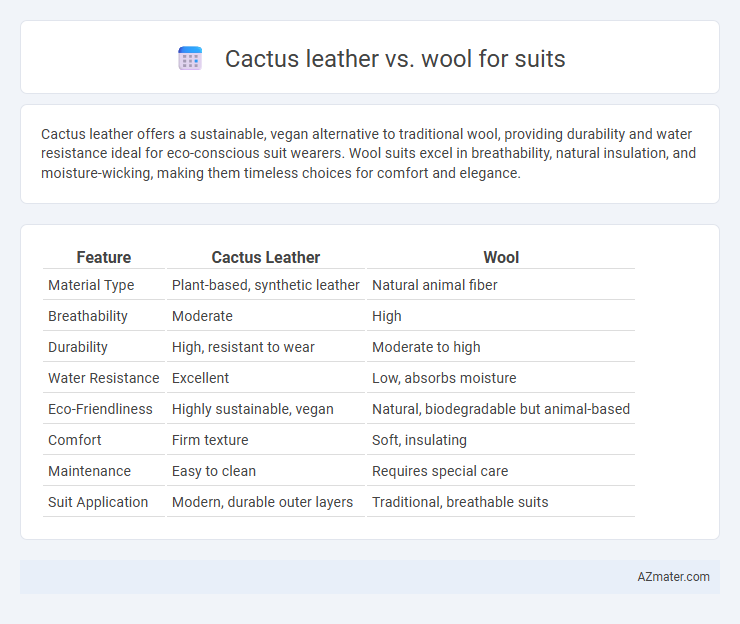Cactus leather offers a sustainable, vegan alternative to traditional wool, providing durability and water resistance ideal for eco-conscious suit wearers. Wool suits excel in breathability, natural insulation, and moisture-wicking, making them timeless choices for comfort and elegance.
Table of Comparison
| Feature | Cactus Leather | Wool |
|---|---|---|
| Material Type | Plant-based, synthetic leather | Natural animal fiber |
| Breathability | Moderate | High |
| Durability | High, resistant to wear | Moderate to high |
| Water Resistance | Excellent | Low, absorbs moisture |
| Eco-Friendliness | Highly sustainable, vegan | Natural, biodegradable but animal-based |
| Comfort | Firm texture | Soft, insulating |
| Maintenance | Easy to clean | Requires special care |
| Suit Application | Modern, durable outer layers | Traditional, breathable suits |
Introduction to Sustainable Suit Fabrics
Cactus leather and wool represent two compelling sustainable suit fabric options, each with unique environmental benefits. Cactus leather is plant-based, biodegradable, and requires significantly less water and chemicals compared to traditional leather, making it an eco-friendly alternative for modern suiting. Wool, naturally renewable and biodegradable, offers excellent breathability and durability, with responsible sourcing practices enhancing its sustainability profile in suit manufacturing.
Overview of Cactus Leather
Cactus leather offers a sustainable and eco-friendly alternative to traditional textiles, made from the mature leaves of the nopal cactus. It boasts a durable, water-resistant surface with a natural texture similar to animal leather, making it suitable for fashion applications including suits and accessories. Unlike wool, cactus leather requires less water and emits fewer greenhouse gases during production, aligning with environmentally conscious manufacturing practices.
Overview of Wool as a Classic Fabric
Wool is a timeless fabric renowned for its breathability, natural insulation, and durability, making it a preferred choice for classic suits. Its ability to regulate temperature and wick moisture enhances comfort in various climates, while its natural elasticity helps maintain garment shape and resist wrinkles. Wool's versatility and luxurious texture contribute to its enduring popularity in formal and professional attire.
Environmental Impact: Cactus Leather vs Wool
Cactus leather significantly reduces environmental impact by requiring less water, no pesticides, and producing minimal greenhouse gas emissions compared to traditional wool, which demands extensive land use, large water consumption, and methane emissions from sheep. The sustainable cultivation of cactus plants also supports biodiversity and soil health, whereas wool production contributes to overgrazing and habitat degradation. Cactus leather offers a low-carbon, cruelty-free alternative, making it a more eco-friendly choice for suit materials.
Durability and Longevity Comparison
Cactus leather offers impressive durability with its resistance to wear, water, and UV rays, making it a sustainable and long-lasting option for suit material. Wool is renowned for its natural resilience, breathability, and ability to maintain shape over time, but it may be more susceptible to moisture damage and pilling compared to cactus leather. When comparing longevity, cactus leather suits can last for years without significant degradation, while high-quality wool suits require careful maintenance to preserve their durability and aesthetic appeal.
Comfort and Breathability
Cactus leather offers excellent breathability and moisture-wicking properties, making it a comfortable choice for suits in warm climates, while its softness adapts well to body movements. Wool suits provide superior temperature regulation and natural insulation, ensuring comfort in both cool and moderately warm conditions, with fibers that allow airflow to prevent overheating. Both materials enhance comfort, but cactus leather excels in ventilation, whereas wool delivers balanced warmth and breathability.
Style and Aesthetic Appeal
Cactus leather offers a sleek, modern aesthetic with a smooth texture and subtle sheen that creates a contemporary and eco-friendly style statement for suits. Wool, known for its rich texture and natural drape, conveys timeless elegance and sophistication with a classic matte finish ideal for formal and traditional settings. The choice between cactus leather and wool ultimately hinges on a preference for innovative, sustainable fashion versus enduring heritage and warmth in suit design.
Care and Maintenance Requirements
Cactus leather requires minimal care, needing only occasional wiping with a damp cloth and natural conditioning to maintain its texture and durability, making it highly resistant to water and stains compared to traditional materials. Wool suits demand regular brushing, airing, and professional dry cleaning to preserve fabric quality and prevent shrinkage or deformation, particularly because of wool's sensitivity to moisture and heat. The sustainable, low-maintenance nature of cactus leather offers an eco-friendly alternative that reduces the frequency and complexity of care compared to the more labor-intensive upkeep required for wool suits.
Ethical Considerations and Animal Welfare
Cactus leather offers a sustainable and cruelty-free alternative to traditional wool, eliminating concerns about animal exploitation and cruelty often associated with sheep farming. Wool production involves practices like shearing and sometimes mulesing, which raise ethical questions regarding animal welfare. Choosing cactus leather supports environmentally responsible fashion by reducing reliance on animal-derived materials and minimizing the ecological footprint tied to livestock.
Price Comparison and Market Availability
Cactus leather suits typically command higher prices due to their sustainable, eco-friendly production processes and emerging market status, often ranging between $500 to $1,500, while wool suits are more widely available and affordable, generally priced from $300 to $1,000 depending on quality. Market availability for wool suits is extensive, supported by decades of well-established supply chains and retail presence globally, whereas cactus leather suits remain niche with limited manufacturers and primarily online or specialized eco-fashion outlets. The price difference reflects the novelty and sustainability premium of cactus leather compared to the traditional, mass-produced wool suits.

Infographic: Cactus leather vs Wool for Suit
 azmater.com
azmater.com